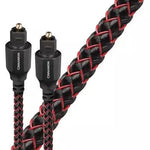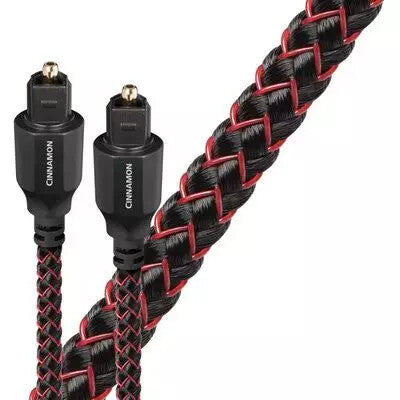
There is another serious scattering mechanism in the Toslink system. The fiber is relatively thick at 1.0 mm in diameter and the LED light source is also relatively large, so the light is “sprayed” into the fiber at many different angles.
AudioQuest OptiLink Cinnamon
AudioQuest OptiLink Cinnamon - The possibilities opened up by HDMI, USB, FireWire® and Ethernet connections ensure a lot of movement on the audio front. However, the current generation of digital technologies is only part of the story; The challenge of designing, manufacturing and selecting the best analog cables and speaker cables still exists. S/PDIF (Sony® Philips Digital InterFace), which debuted in 1983 at the same time as the CD, is still part of the audio world. S/PDIF is transmitted over digital coax and Toslink fibers, making these still the most important cables in electronic entertainment.
While HDMI is more commonly used than Toslink to connect a DVD player to an AV receiver, Toslink connections are common for cable receivers, TVs, subwoofers and all sorts of other products. The 3.5mm miniplug, also somewhat incorrectly referred to as mini-Toslink, can now be found virtually everywhere... from the 3.5mm headphone jack on a Mac laptop to inputs on some of the highest-end portable devices.
For these reasons, AudioQuest has improved and renewed the line of high-performance OptiLink cables. All models and lengths are now available in Toslink to Toslink and Toslink to 3.5mm miniplug versions.
The question “How can a fiber optic cable change the sound?” is easier to answer than for any other type of cable. If the light source were a coherent laser beam emitted into a vacuum, the light beams would remain straight and all arrive at their destination at the same time. Even if the LED light source in a Toslink system were to shine contiguously, the light would be scattered as it enters the fiber optic cable due to defects and impurities in the fibers. This can be measured as a loss of amplitude; However, the amplitude is not the problem: 50% loss would have no effect on the sound quality.
AudioQuest OptiLink Cinnamon - The problem is that the scattered light passes through the cable, but does not travel the direct path - comparable to a billiard ball that is played over the boards and therefore takes longer than the one that rolls in a direct path. until she arrives at her destination. This missing piece of the signal prevents the computer responsible for decoding from doing its job without errors - or at all. The difficulties in decoding first become apparent at the higher frequencies (not audio frequencies, as this is a monostream of digital audio information), so reduced bandwidth is measurable evidence of the scattering of light by the fibers. The consequence: the less scattering in the fiber, the less distortion in the audio signal that ultimately reaches our ears.
There is another serious scattering mechanism in the Toslink system. The fiber is relatively thick at 1.0 mm in diameter and the LED light source is also relatively large, so the light is “sprayed” into the fiber at many different angles. Even if the fiber were absolutely perfect, there would be time shifts in the signal because the light bundles enter the fiber at different angles and therefore travel different distances until they arrive with different delays. A comprehensive solution to this problem is to use hundreds of significantly smaller ones Combine fibers into a 1.0 mm bundle. This means that the angles at which the light can enter this fiber are limited, there are significantly fewer differences and therefore less scattering over time. This effect achieved by the narrow opening is comparable to the principle of a pinhole camera, which can take photos without a lens: by only letting the light through at a limited angle, the camera can take a photo - you would use the lens of a camera with a larger one Removing the opening would make photography impossible. Less light passes through a multi-fiber cable, but the light that travels through the cable arrives at the other end within a much smaller time window.
So the problem is the scattering of light over a certain period of time - here two ways lead to better results: less scattering in the fiber (better polymers and ultimately quartz) and less scattering by limiting the entrance angle. Simple but true. Listen and enjoy.

